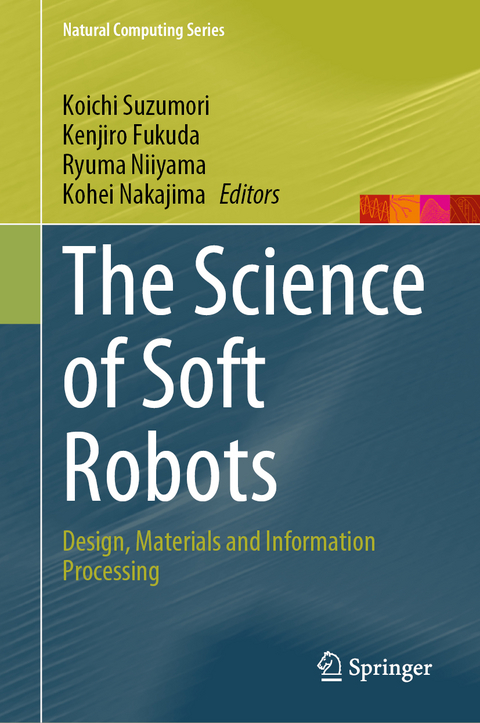
The Science of Soft Robots
Design, Materials and Information Processing
Seiten
2023
|
2023 ed.
Springer Verlag, Singapore
978-981-19-5173-2 (ISBN)
Springer Verlag, Singapore
978-981-19-5173-2 (ISBN)
The goal of this textbook is to equip readers with as structured knowledge of soft robotics as possible. Soft robotics is also highly interdisciplinary, bringing together robotics, computer science, material science, biology, etc.
After the introduction, the content is divided into three parts: Design of Soft Robots;
The goal of this textbook is to equip readers with as structured knowledge of soft robotics as possible. Seeking to overcome the limitations of conventional robots by making them more flexible, gentle and adaptable, soft robotics has become one of the most active fields over the last decade. Soft robotics is also highly interdisciplinary, bringing together robotics, computer science, material science, biology, etc.
After the introduction, the content is divided into three parts: Design of Soft Robots; Soft Materials; and Autonomous Soft Robots. Part I addresses soft mechanisms, biological mechanisms, and soft manipulation & locomotion. In Part II, the basics of polymer, biological materials, flexible & stretchable sensors, and soft actuators are discussed from a materials science standpoint. In turn, Part III focuses on modeling & control of continuum bodies, material intelligence, and information processing using soft body dynamics. In addition, the latest research resultsand cutting-edge research are highlighted throughout the book.
Written by a team of researchers from highly diverse fields, the work offers a valuable textbook or technical guide for all students, engineers and researchers who are interested in soft robotics.
After the introduction, the content is divided into three parts: Design of Soft Robots;
The goal of this textbook is to equip readers with as structured knowledge of soft robotics as possible. Seeking to overcome the limitations of conventional robots by making them more flexible, gentle and adaptable, soft robotics has become one of the most active fields over the last decade. Soft robotics is also highly interdisciplinary, bringing together robotics, computer science, material science, biology, etc.
After the introduction, the content is divided into three parts: Design of Soft Robots; Soft Materials; and Autonomous Soft Robots. Part I addresses soft mechanisms, biological mechanisms, and soft manipulation & locomotion. In Part II, the basics of polymer, biological materials, flexible & stretchable sensors, and soft actuators are discussed from a materials science standpoint. In turn, Part III focuses on modeling & control of continuum bodies, material intelligence, and information processing using soft body dynamics. In addition, the latest research resultsand cutting-edge research are highlighted throughout the book.
Written by a team of researchers from highly diverse fields, the work offers a valuable textbook or technical guide for all students, engineers and researchers who are interested in soft robotics.
Koichi Suzumori is a professor at Tokyo Institute of Technology.Kenjiro Fukuda is a senior research scientist at RIKEN Center for Emergent Matter Science.Ryuma Niiyama is an associate professor at Meiji University.Kohei Nakajima is an associate professor at the University of Tokyo.
Chapter 1: Introduction.- Chapter 2: Soft Mechanisms.- Chapter 3: Biological Mechanisms.- Chapter 4: Soft Manipulation and Locomotion.- Chapter 5: Basics of Polymer.- Chapter 6: Biological Material.- Chapter 7: Flexible and Stretchable Sensors.- Chapter 8: Soft Actuators.- Chapter 9: Modeling and Control of Continuum Body.- Chapter 10: Material Intelligence.- Chapter 11: Information Processing using Soft Body Dynamics.
| Erscheinungsdatum | 14.09.2023 |
|---|---|
| Reihe/Serie | Natural Computing Series |
| Zusatzinfo | 131 Illustrations, color; 82 Illustrations, black and white; XVI, 406 p. 213 illus., 131 illus. in color. |
| Verlagsort | Singapore |
| Sprache | englisch |
| Maße | 155 x 235 mm |
| Themenwelt | Informatik ► Theorie / Studium ► Künstliche Intelligenz / Robotik |
| Naturwissenschaften ► Physik / Astronomie ► Angewandte Physik | |
| Technik ► Elektrotechnik / Energietechnik | |
| ISBN-10 | 981-19-5173-X / 981195173X |
| ISBN-13 | 978-981-19-5173-2 / 9789811951732 |
| Zustand | Neuware |
| Informationen gemäß Produktsicherheitsverordnung (GPSR) | |
| Haben Sie eine Frage zum Produkt? |
Mehr entdecken
aus dem Bereich
aus dem Bereich
Buch | Softcover (2024)
REDLINE (Verlag)
20,00 €
Eine kurze Geschichte der Informationsnetzwerke von der Steinzeit bis …
Buch | Hardcover (2024)
Penguin (Verlag)
28,00 €


